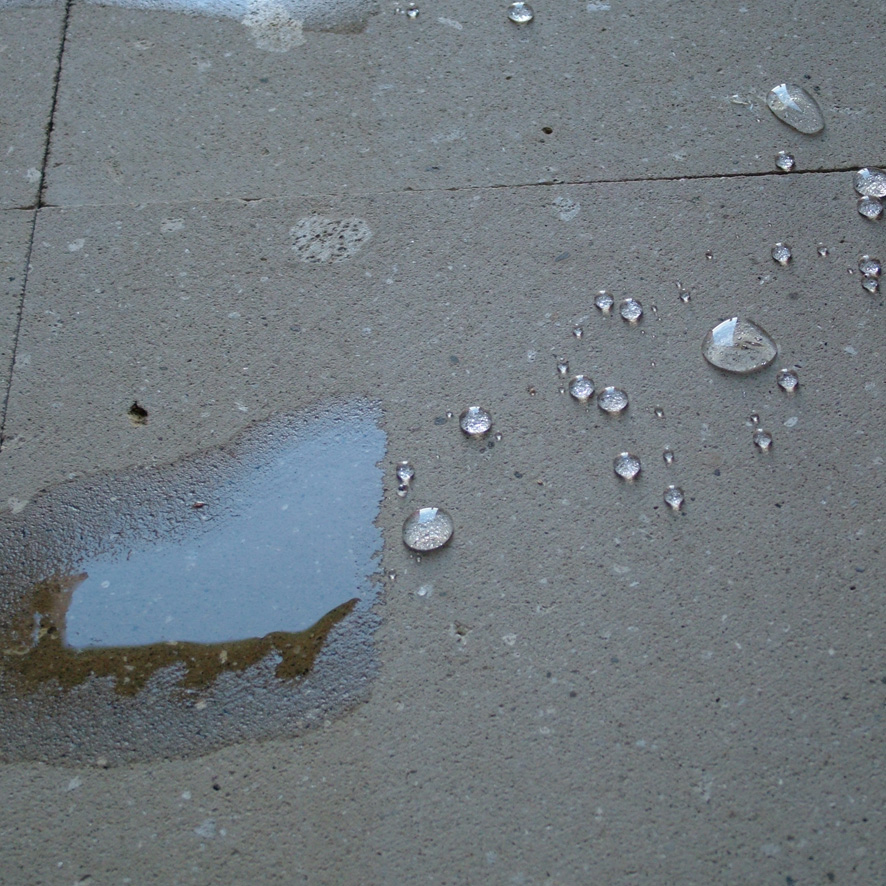Tiles and stone are premium flooring materials, providing a certain level of prestige and commanding a premium price. Why not protect that investment? Tile Sealing and Protective Coatings will provide different levels of protection, making sure the surface has a long life looking as good as possible.
Sealing stone
Sealing natural stone surfaces is a highly specialised process, as the selection of the correct sealer is critical. There are many different types of natural stone with different characteristics, and the sealer must be matched not only to the stone type, but also to the location of the surface.
Porous stone in outdoor areas (such as sandstone and limestone) need a water-repellent stone sealer to reduce mould growth; while stone benchtops in kitchens or around eating areas should be treated with a grease- and oil-repellent stone sealer for best levels of protection.
All stone surfaces can stain because they are naturally absorbent. Because of their absorbency, even general dirt and grime ground into the surface can penetrate and become harder to remove.
If there is a bad spill (oil, spray tan, food colouring etc) it can penetrate very deeply into the stone, to the point that it might not be able to be removed.
Sealing your stone surfaces with a high quality penetrating sealer will reduce the stone’s absorbency. This will stop spills from instantly staining, as well as making the stone easier to clean. It also stops bad spills from penetrating deeply, so even if they do leave a mark it is much higher within the surface of the stone and therefore easier to remove.
Stone sealers are generally penetrating (sitting inside the surface of the stone), although in certain situations a topical sealer or coating system can be beneficial. Please see our Polishes and Coatings section for more information on this.

Sealing ceramic and porcelain tiles
Glazed ceramic and porcelain tiles don’t usually require a sealer application because they are inherently hard-wearing. However there are cases where these surfaces can benefit from the application of a sealer.
Unglazed Ceramic Tiles
Unglazed ceramics (also known as encaustic tiles) are extremely absorbent, and can mark and stain very easily. These surfaces should have a penetrating sealer or surface coating applied to protect them and make them easier to keep clean.
Porcelain Tiles
Porcelain tiles when made with top quality clay and well processed generally do not need a sealer. As the market has grown and moved away from traditional manufacture powerhouses the price has dropped because manufacturers are using cheaper quality clay and reducing quality control methods. This has led to a range of porcelain tiles that can take a penetrating sealer, which can help to reduce staining and make the tile easier to keep clean.
Polished Porcelain Tiles
Polished porcelain is an interesting exception to the rule of sealing tiles. While the tile itself might be of best quality clay and inherently non-absorbent, the tile is actually ground to create the smooth, polished finish. This grinding process opens up a fine pore on the surface of the tile. While technically still non-absorbent, the small opening can allow moisture in and stain. Traditional sealers cannot get into these small openings but there are a range of sealers specifically designed to get into these pores and plug them, which stops the staining process and makes the tiles easier to clean.
Textured Porcelain Tiles
Highly textured porcelain tiles are non-absorbent, but the texture means that they can mark and discolour easily as dirt and grime gets into the fine texture. This is often very difficult to remove. There is a sealer specifically designed for this problem. It does not soak into the tile (as it is not absorbent) but chemically fuses into the tile’s surface. This process does not alter slip, but changes the surface tension to reduce marking, and makes the tile easier to remove future contamination.
Consolidating sealers
Softer stone like limestone and sandstone can experience spalling, where salt ingress can physically damage the stone, leading to the surface flaking away. A consolidating sealer acts as a binding agent to physically strengthen the stone making it less likely to spall. This is a great treatment for stone around salt water pools, or close to the ocean.
Sealing grout
Even if your tiles aren’t absorbent, the grout joints around them are. The majority of grout is made from cement, which is very porous, so it soaks up water and stains easily. Grout Sealing will make it less absorbent, less likely to stain, and much easier to keep clean.
Stained and discoloured grout can give a very patchy and dirty appearance to a floor. Slique can remove contamination from grout joints before any grout sealing process is completed.
Grout sealing can either be invisible – reducing the absorbency of the grout without changing it’s colour – or you can choose to recolour the grout. All grout sealing treatments will reduce mould growth, stop spills from instantly staining, and make dirt and grime easier to remove in the future.
Which stone sealer? Solvent or water-based?
There is often misinformation in the industry about solvent vs water-based sealers, with opinions being offered on one type being more effective than the other. The solvent or water is simply the carrying mechanism for the active ingredients in the sealer, and actually evaporates away over time, so in our experience it is not right to say one type is better than the other.
Generally, you can differentiate between the two by considering that water-based sealers are generally better at carrying the sealer into more absorbent types of stone, and solvent-based sealers are generally better at carrying the sealer into denser stone and tiles.